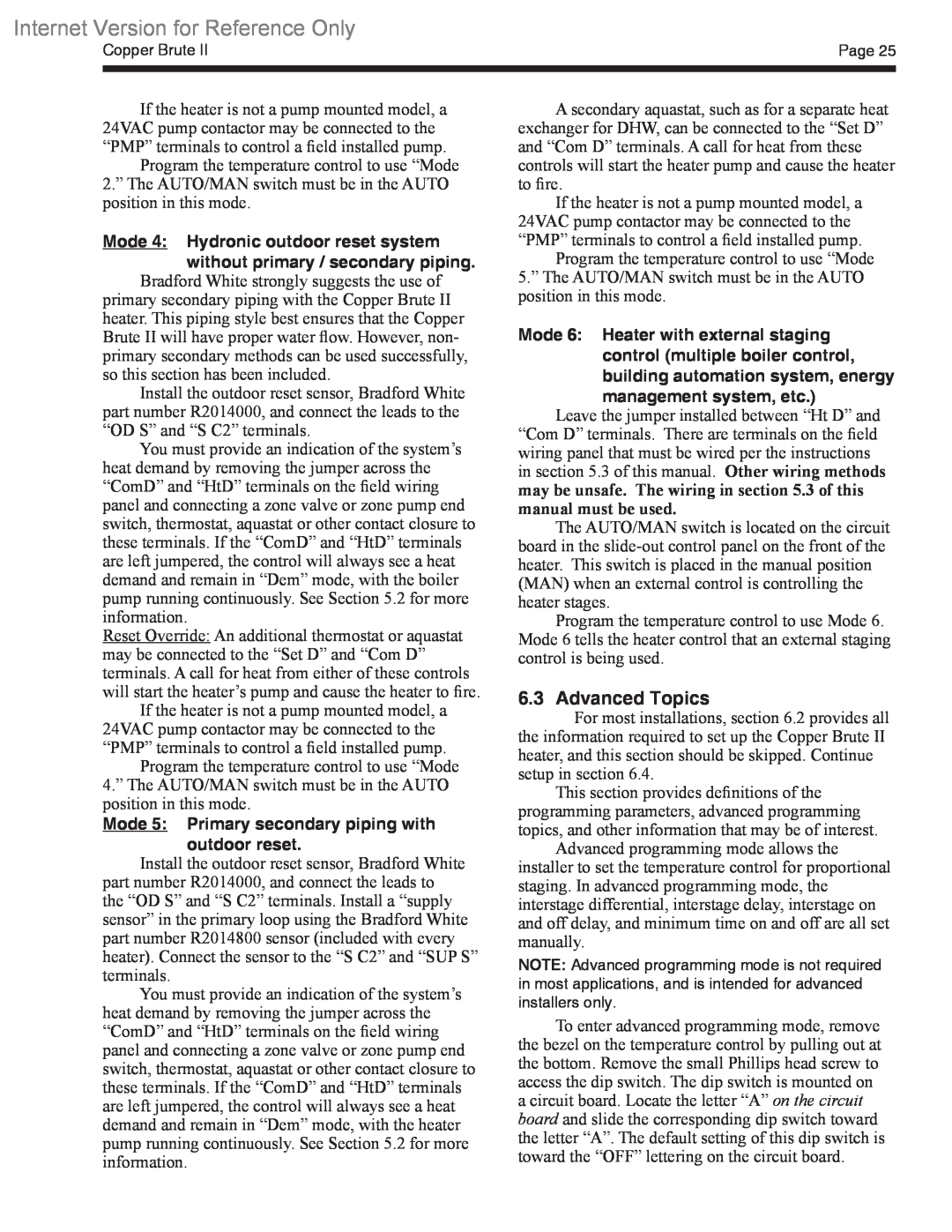Internet Version for Reference Only
Copper Brute II | Page 25 |
|
|
|
|
If the heater is not a pump mounted model, a 24VAC pump contactor may be connected to the “PMP” terminals to control a field installed pump.
Program the temperature control to use “Mode 2.” The AUTO/MAN switch must be in the AUTO position in this mode.
Mode 4: Hydronic outdoor reset system without primary / secondary piping.
Bradford White strongly suggests the use of primary secondary piping with the Copper Brute II heater. This piping style best ensures that the Copper Brute II will have proper water flow. However, non- primary secondary methods can be used successfully, so this section has been included.
Install the outdoor reset sensor, Bradford White part number R2014000, and connect the leads to the “OD S” and “S C2” terminals.
You must provide an indication of the system’s heat demand by removing the jumper across the “ComD” and “HtD” terminals on the field wiring panel and connecting a zone valve or zone pump end switch, thermostat, aquastat or other contact closure to these terminals. If the “ComD” and “HtD” terminals are left jumpered, the control will always see a heat demand and remain in “Dem” mode, with the boiler pump running continuously. See Section 5.2 for more information.
Reset Override: An additional thermostat or aquastat may be connected to the “Set D” and “Com D” terminals. A call for heat from either of these controls will start the heater’s pump and cause the heater to fire.
If the heater is not a pump mounted model, a 24VAC pump contactor may be connected to the “PMP” terminals to control a field installed pump.
Program the temperature control to use “Mode 4.” The AUTO/MAN switch must be in the AUTO position in this mode.
Mode 5: Primary secondary piping with outdoor reset.
Install the outdoor reset sensor, Bradford White part number R2014000, and connect the leads to the “OD S” and “S C2” terminals. Install a “supply sensor” in the primary loop using the Bradford White part number R2014800 sensor (included with every heater). Connect the sensor to the “S C2” and “SUP S” terminals.
You must provide an indication of the system’s heat demand by removing the jumper across the “ComD” and “HtD” terminals on the field wiring panel and connecting a zone valve or zone pump end switch, thermostat, aquastat or other contact closure to these terminals. If the “ComD” and “HtD” terminals are left jumpered, the control will always see a heat demand and remain in “Dem” mode, with the heater pump running continuously. See Section 5.2 for more information.
A secondary aquastat, such as for a separate heat exchanger for DHW, can be connected to the “Set D” and “Com D” terminals. A call for heat from these controls will start the heater pump and cause the heater to fire.
If the heater is not a pump mounted model, a 24VAC pump contactor may be connected to the “PMP” terminals to control a field installed pump.
Program the temperature control to use “Mode 5.” The AUTO/MAN switch must be in the AUTO position in this mode.
Mode 6: Heater with external staging control (multiple boiler control, building automation system, energy management system, etc.)
Leave the jumper installed between “Ht D” and “Com D” terminals. There are terminals on the field wiring panel that must be wired per the instructions in section 5.3 of this manual. Other wiring methods may be unsafe. The wiring in section 5.3 of this manual must be used.
The AUTO/MAN switch is located on the circuit board in the
Program the temperature control to use Mode 6. Mode 6 tells the heater control that an external staging control is being used.
6.3 Advanced Topics
For most installations, section 6.2 provides all the information required to set up the Copper Brute II heater, and this section should be skipped. Continue setup in section 6.4.
This section provides definitions of the
programming parameters, advanced programming topics, and other information that may be of interest. Advanced programming mode allows the
installer to set the temperature control for proportional staging. In advanced programming mode, the interstage differential, interstage delay, interstage on and off delay, and minimum time on and off are all set manually.
NOTE: Advanced programming mode is not required in most applications, and is intended for advanced installers only.
To enter advanced programming mode, remove the bezel on the temperature control by pulling out at the bottom. Remove the small Phillips head screw to access the dip switch. The dip switch is mounted on a circuit board. Locate the letter “A” on the circuit board and slide the corresponding dip switch toward the letter “A”. The default setting of this dip switch is toward the “OFF” lettering on the circuit board.
